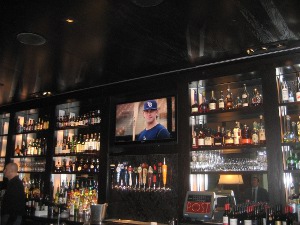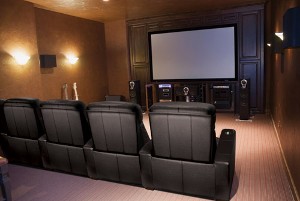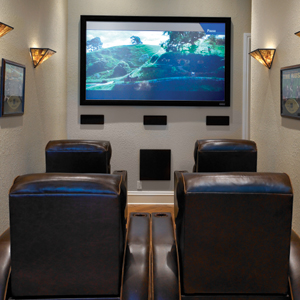
LED vs LCD TVs
How are LED TVs different from LCD TVs?
Simply stated, an LED TV is an LCD TV that is lit with an LED (light emitting diode) light source instead of CCFLs (cold cathode fluorescent lamp). Manufacturers such as Samsung began the trend of marketing the LED-lit LCD TV as an “LED TV” likely in an attempt to easily differentiate the product from typical CCFL lit LCD products.While an LED TV is still technically an LCD TV, just get used to seeing this type of designation. We don’t really have a problem with it and it does, among other things, seem to make it easier to say it out loud.

An LCD TV is comprised of several layers. The front layer is a piece of glass filled with liquid crystals that move and change to produce the images we see on the screen. But images can only be viewed when the screen is illuminated. This requires a light source. The light source is the difference between LED TV and conventional LCD TV.
Here’s a simple explanation of how it works: Conventional LCD TVs use fluorescent tubes (CCFL) to provide light to illuminate the LCD panel and make the images viewable. In an LED TV, the LCD panel is lit from behind with an LED-based backlight. LED lights can be more precisely controlled and can produce richer blacks and a better contrast ratio for a more vivid viewing experience.
Edge Lit vs. Rear Lit
With LED TVs, edge-lit technology is what allows some sets to be less than 1-inch thick. The LEDs are actually arranged around the very edge of the screen, allowing the display to be very thin, since the lighting technology isn’t positioned behind the screen. While this does indeed grant a thinner display, it typically (this is changing now) precludes te manufacturer from setting up a system that optimizes contrast across various areas of the screen.

Smart Dimming and Zones
Several manufacturers are optimizing their LED backlit displays to produce different amounts of backlighting on different areas of the screen. In this way, you can see content that contains bright areas on the screen along with very black areas. Think of a candle lit in a dark room. With your typical edge lit display you have one level for the overall backlight. With Smart Dimming, you can brightly light the part of the screen with teh candle, and then all but turn off the LEDs behind the black areas of the screen.
Should you expect to pay more for LED TV? What are the benefits of LED vs. LCD?
LED TVs like those form Westinghouse Digital are often edge-lit, which means they are generally more energy efficient, weigh less and cost less than full array LED TVs. Some LED TVs are engineered and produced so efficiently that they may even cost less than conventional CCFL lit LCD TVs. The bottom line is that LEDs are getting cheaper and cheaper and soon we estimate they will actually be easier and cheaper to produe than CCFL backlit displays.
LED TVs in general use less energy (and are therefore more efficient and economical to operate) than conventional LCD TVs. LED TVs are also thinner and weigh less than LCD TVs and generally create a brighter picture. For those who are environmentally concerned, LED TVs also contain no Mercury or Lead.
Presented by Westinghouse Digital and edited by Clint DeBoer
http://www.audioholics.com/education/display-formats-technology/led-vs-lcd-tvs
Custom Installation Services, LLC – First choice for low voltage wiring in Charlotte, NC and surrounding areas
Posted in 3D TV, Blu-ray, Flat Panel TV's, Gaming Systems, HDMI Specs, Home Theater, LED, Low Voltage Contractors, Media Rooms, Multi Room A/V, Music and Movies, News, recycling, Structured Wiring
|
Tagged 3d theater in charlotte, audio advice, Best Buy, Blu-ray, central vac dealers in charlotte nc, charlotte audio advice, charlotte custom home builders, connect wii to tv, custom home builders in charlotte nc, geek squad in charlotte nc, HD installers in Charlotte nc, Home theater installers Lake Norman, hook up xbox, innovative systems, LCD TV Installation, LED TV Installation, Low voltage contractors, Marantz, marantz dealers in Charlotte nc, speakercraft dealers in charlotte nc, tv installation, tweeter charlotte, Universal Remote programmers in charlotte nc, zobo
|
Integrator Serves Up 87 Restaurant Speakers
 Boston’s Post 390 blanketed with SpeakerCraft speakers and Crestron automation. Boston’s Post 390 blanketed with SpeakerCraft speakers and Crestron automation.
Providing audio, video and automation for a bar and restaurant is rarely easy. It’s even more difficult when the restaurateur has various and specific goals in mind.
Take Post 390, for example, which is located steps from Boston’s most bustling office buildings, making it an after-work cocktail location. It’s also located a couple of blocks from Boston Back Bay’s bar scene, making it a night-on-the-town location.
But Post 390 is located a stone’s throw from Boston’s trendy South End restaurants, making it an up-scale eatery.
In other words: Post 390 needs to be a chameleon, adjusting to the needs of various guests – and its audio, video and automation need to reflect that.
“One of our early marketing slogans was ‘Find your Post,’” says Paul Dias, senior VP of operations for the Himmel Hospitality Group, which runs Post 390. “We looked at it as a place for a casual lunch, for a business lunch, a place to meet for beers, a place for a formal dinner. So every part of the restaurant had to be able to [reflect] the ‘Find your Post’ theme.”
Photos: Integrator Serves Up 87 Restaurant Speakers
Sound Approach
Dias enlisted North Easton, Mass.-based Audio Video Intelligence (AVI) to design and install Post 390’s electronics.
The restaurant is two floors, with a bar area on each floor, and the dining rooms blend into the bars. There are two areas that can be dedicated for private parties, complete with drop-down Epson projectors and Da-Lite screens, that require separate automation and audio zones.
The biggest challenge for Jim Shapiro, president of AVI, was providing seamless sound – a dilemma he describes while walking across the length of the restaurant and listening for hotspots. “In a restaurant, more speakers are generally better. If there are too few, the system has to play louder and that’s when people get upset.”
As such, AVI installed 87 SpeakerCraft speakers and subwoofers, mostly in-ceiling, in the 12,000-square-foot space.
AVI’s design called for even more speakers. “Yeah,” Dias recalls. “You [as a restaurant integration client] really have to come to terms with the number of speakers. You have to compromise. You only have as much money as you have to spend.”
Automation Made Easy
Speaking of money, Post 390 didn’t skimp when it came to automation. Post 390 staff use Crestron automation to control audio, video, motorized screens, lighting and climate. It’s always a challenge anytime various employees need to interact with a control system, so Dias wanted it to be as simple as possible.
During the design phase, Shapiro sent Dias screen captures of the customized Crestron interfaces AVI programmed for Post 390. He liked what he saw.
Dias, whose Himmel Hospitality Group runs other prominent Boston and Cambridge restaurants, has been burned before by difficult-to-use automation systems.
“Paul knew he needed reliability and it needed to be simple to control,” says Shapiro. “He had experiences with systems that aren’t as powerful and fast for switching.”
Post 390 demonstrates extreme confidence in its Crestron automation system by including in-wall touchscreens in the two private dining areas. Nothing is stopping a customer in one of those rooms to select music, turn down volume or even lower the projector and screen – although it’s obviously not encouraged.
The private rooms are only private when Post 390 designates it so. The larger of the rooms includes a large glass door that can be opened when that room is simply used for dining space and closed when privacy is needed.
The audio zones need to reflect the rooms’ usage and Post 390 staff uses Crestron audio switching via touchscreen to change on the fly.
Staff training was a snap, Shapiro recalls. He remembers being on-site for a soft opening and waiting for employees to ask questions about how to use the automation system but hardly getting any. For him, that’s a measure of success.
For Dias, he measures success by reflecting back on his initial goals. “We were trying to create a certain kind of environment here and we wanted a sound system that would help us do that. And we wanted consistency.”
Walking through the restaurant, Dias says his goals were met. Then he adds, “See? No dead spots.”
by Tom LeBlanc
http://www.commercialintegrator.com/article/integrator_serves_up_87_restaurant_speakers?utm_source=ci&utm_medium=topic
Custom Installation Services, LLC – Charlotte, NC’s Source For Restaurant and Sports Bar Audio/Video Sales, Service and Installation
Posted in Audio Systems, Automation, Flat Panel TV's, LED, lighting control, Multi Room A/V, Outdoor Speakers, Panamax, Structured Wiring
|
Tagged 3d theater in charlotte, audio advice, central vac dealers in charlotte nc, charlotte a/v, charlotte audio advice, Charlotte Commercial A/V, charlotte hd installers, commercial audio video charlotte, custom home builders in charlotte nc, geek squad in charlotte nc, hd installers charlotte, home automation companies in charlotte, home theater furniture, Home theater installers Lake Norman, marantz dealers in Charlotte nc, multiroom audio, speakercraft dealers in charlotte nc, sports bar audio video charlotte, zobo
|
Home Theater Basics: 12 Things for Newbies
 C.I.S. - Charlotte's Home Theater Company! All you really need to have a home theater are speakers, some basic audio/video equipment and some popcorn.
Getting a basic home theater system into your house may be far simpler than you think. You just need to understand what the basic components are and match them to your budget and performance needs.
At an elemental level, a home theater system needs a large video display device (generally a flat panel TV 50-inches and up or a projector/screen), a surround-sound speaker setup (at least 5.1 plus electronics for switching and processing), and some quality source components (Blu-ray, cable, streaming devices …) . That’s it. Sure, it can be a little more involved, but it isn’t rocket science. Here’s a more thorough breakdown of today’s home theater basics:
The Sights
1. A video display can be any size or style you want, as long as it’s big. For an immersive experience, we generally suggest a screen of at least 50 inches (measure diagonally), but smaller screens may make sense in some rooms. Your display will, of course, be high definition, and mostly likely 1080p resolution, though some 720p resolution TVs are still available.
When you’re planning your theater, a guideline for display size is that the viewing distance (the distance from you to the screen) should be 2 to 3 times the width of the screen (actually width, not the diagonal size).
2. A video display can utilize one of several technologies such as plasma, LCD (liquid crystal display), DLP (digital light processing), LCoS (liquid crystal on silicon) or some others. All of these technologies have their pros and cons, but all can create a home theater-quality picture at a variety of budgets.
3. The type of video display you choose will depend on your budget, how you intend to use the display and the space where you plan to enjoy your home theater. There are lots of options, but your selection will be made easier if you know what you’re seeking.
4. Think 3D. Stereoscopic, or 3D, started getting serious attention last year, and this year that attention is even greater. A 3D TV truly separates a home theater from simply a television as it adds one more element that, until recently, was unique to commercial theaters. Plus, all the technology that goes into make a TV 3D, also happens to make it an even better 2D TV for conventional viewing.
 The Sounds The Sounds
5. A home theater’s surround-sound system consists of five or more speakers, with three in the front near the video display and at least two on the sides or at the back of the room.
6. The three front speakers do most of the work to produce sounds that correspond with the action on the screen. Two speakers, called the front left and right channels, are typically placed on either side of the video display. A center-channel speaker is often placed above or below the screen. Two or more speakers on the sides or rear are referred to as surround speakers. Additional rear speakers or even height-channel speakers can create an even more realistic impression on the audience.
7. The center-channel speaker is the most important loudspeaker in a surround-sound setup. This is because it reproduces a great majority of the sounds you hear in a movie soundtrack, including all of the dialogue. You’ll want to hear every word clearly and feel as if the dialogue is coming directly from the actors’ mouths.
8. The role of surround speakers is to convey ambient sounds, such as background noises, rumbles or passing cars or planes. These speakers help fully immerse you in a movie. The surround sound speakers generally shouldn’t be too obvious to the listener, so don’t crank them up too loud or the effect will be unnatural.
9. There are several surround speaker options. You can have two speakers, one on each side of the seating area. You can have three speakers, with one on each side and one in the back, allowing you to better hear the effects of movement such as that of a passing car or a train or airplane. You can have four speakers, with two on each side. Or you can have even more speakers. It’s really a matter of how far you want to go.
10. Specialty speakers called subwoofers produce low bass sounds so you will hear the full impact of sound effects such as explosions or the roar of a jet engine. Subwoofers can be placed virtually anywhere. People often put them in a front corner, behind a plant or a table or even under a couch. Subwoofers are not full-range speaker channels, meaning they only produce a fraction of the sounds you hear. In surround-sound parlance, subwoofers represent the “.1” in 5.1, 6.1 or 7.1 systems (5.1 meaning the basic surround-sound setup of five speaker channels plus a subwoofer, 6.1 meaning six channels and a subwoofer and 7.1 meaning seven channels plus a subwoofer). Multiple subwoofers can also be used.
11. To get sound to the speakers and video to the screen, you’ll need switching and processing components like a surround-sound receiver or a controller and amplifier. Receivers contain amplifiers, precluding the need for a separate amplifier, though for higher performance you may opt for a separate surround-sound controller and a power amplifier. Look for a receiver with multiple HDMI inputs (version 1.4 is the latest) for all your sources. Additional features such as iPods connectively, Internet radio, DLNA, multi-zone and audio calibration systems can add to your home theater’s functionality and ease of use.
12. Sources for all Tastes. Well, of course you’ll want something to watch, right? For most people, the two most fundamental sources will be a TV tuner (cable, FiOS or satellite box) and a Blu-ray player. Other great sources for home theaters include gaming consoles and web media players (such as Roku and similar products). Many Blu-ray players or TVs include built-in web-based services such as Netflix, Vudu and Amazon Instant Video.
by EH Staff
http://www.electronichouse.com/article/12_things_you_need_to_know_about_home_theater/
Custom Installation Services, LLC – ”We may be a few dollars more than the competition, but we are a million times better”.
Posted in Uncategorized
|
Tagged 3d theater in charlotte, audio advice, audio video installers sports bars, Best Buy, business audio video, central vac dealers in charlotte nc, charlotte a/v, charlotte audio advice, charlotte audio video, charlotte hd installers, charlotte nc architects, corporate a/v installation, HD installers in Charlotte nc, home audio consultation and design, home automation companies in charlotte, home theater charlotte, home theater furniture, home theater installers charlotte, innovative systems, marantz dealers in Charlotte nc, sports bar a/v installers, Universal Remote programmers in charlotte nc, whole house audio, zobo
|
|
|
|








